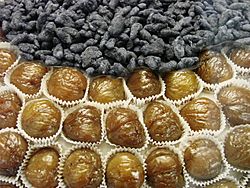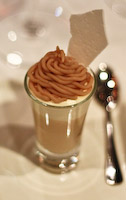Marron glacé facts for kids
 |
|
| Type | Confectionery |
|---|---|
| Place of origin | Northern Italy/Southern France |
| Region or state | Piedmont/Rhône-Alpes |
| Main ingredients | Chestnuts, sugar |
A marron glacé (say "mah-RON glah-SAY") is a yummy sweet treat. It's made from a special type of chestnut that's been cooked in sugary syrup and then given a shiny glaze. Marrons glacés come from northern Italy and southern France. People enjoy them on their own or use them in many delicious desserts.
Contents
The Sweet Story of Marron Glacés
Candied chestnuts first appeared in areas where chestnuts grew, like northern Italy and southern France. This happened a long time ago, after crusaders brought sugar back to Europe. Using sugar in cooking allowed people to create many new sweets.
A candied chestnut treat was likely served around the early 1400s in places like Piedmont, Italy. But the marron glacé as we know it today, with its special shiny glaze, might have been invented in the 1500s. Two cities, Lyon in France and Cuneo in Italy, both claim to have added this important glazing step.
The oldest known recipes for marron glacés were written in the 1500s. One was by an Italian cook working for Charles Emmanuel I, Duke of Savoy in 1580. Another was from the French court of King Louis XIV at Versailles in the late 1600s. In 1667, François Pierre La Varenne, a famous French chef, wrote a best-selling cookbook. In it, he described how to make chestnuts "dry," which might be the first written recipe for marrons glacés.
Towards the end of the 1800s, the city of Lyon was facing tough times because its textile (cloth) market was struggling. Clément Faugier, an engineer, wanted to help the local economy. In 1882, in Privas, France, he and a local candy maker opened the first factory. This factory used new technology to make marrons glacés in larger amounts. Even today, many of the nearly twenty steps to make them are still done by hand!
Three years later, Faugier also created crème de marrons de l'Ardèche. This is a sweet chestnut purée made from marrons glacés that broke during production. It's flavored with vanilla and is very popular.
In 1980, a similar process was started in Ourense, Spain, by José Posada. He built the first factory in Spain to make marrons glacés using local chestnuts from Galicia. Before this, these chestnuts were sent to France. Today, Spain has two factories that make marron glacés.
What's the Difference: Châtaigne vs. Marron?
In France, people use two words for chestnuts: châtaigne and marron. Both come from the same type of tree, the sweet chestnut. However, marron usually means a bigger, better quality chestnut that's easier to peel.
The dictionary from 1798 says that a marron glacé is a marron covered in caramel. An old book from 1767 mentioned that the best marrons came from the Dauphiné region in France and even gave instructions for making marron glacés.
Chestnuts have a thin skin called a pellicle that sticks to the nut's flesh. This skin must be removed because it tastes bitter. Marron nuts have a pellicle that is only "superficially attached," meaning it's easy to peel off. Some chestnuts have two halves inside, which makes them too delicate for the cooking process. They also have deep grooves where the skin gets stuck. Marron quality nuts don't have these problems; they are usually one solid piece with very few shallow grooves.
In Italy, the word marron also means a special, high-quality type of chestnut. These chestnuts are oblong (oval-shaped) with a shiny, reddish skin. Just like the French marron, they should not be divided into two halves inside.
Marron quality nuts, used for marrons glacés, can be three or four times more expensive than châtaigne nuts. This is because they produce fewer nuts per plant, and the husks usually contain only one or two nuts.
How Are Marrons Glacés Used?

Marrons glacés are delicious eaten all by themselves as a sweet treat.
The Crème de marrons (chestnut purée) is a key ingredient for many other desserts. For example, it's used to make the famous Mont Blanc dessert, which is a purée mixed with cream. It's also used in ice creams, cakes, sweet sauces, or as a garnish for other desserts.
Where Else Are They Popular?
Turkey
Candied chestnuts are a special treat in Bursa, Turkey. There, they are called kestane şekeri, which means 'chestnut candy'.
See also
 In Spanish: Castaña confitada para niños
In Spanish: Castaña confitada para niños

